 |
||
|
||
| ||
Today we continue to study videocard series based on GPU from NVIDIA which has just begun to sell in the market. As you remember we have already mentioned the ASUSTeK company many times, for it is a well-known brandname on the market . The company has been working for a long time on the market of videocards and is considered one of the biggest ones there. Videocards from ASUSTeK owes not only high performance to unique architecture and a perfect complete set, but also unique development works of the engineers of the company, which allow to users to adjust the modern videocards to what they need. When the first samples of videocards based on GeForce 2 GTS had appeared, many manufacturers informed of a possible production of 64 MBytes card modifications. Undoubtedly, the high price is the main reason the cards sell bad in the market, that is way the cards with 64 MBytes local memory are produced in rather minor circulations. In fact, the resulting working memory frequency on both card modifications is the same: 333 MHz (only the memory sizes differ). Since the memory does not provide a good potential for performance increase of the powerful GeForce2 GTS, we suppose it is better to use just a faster memory than to extend the local memory size. 3dfx Voodoo5 or RAGE MAXX videocards have 64 MBytes local video memory. The memory is distributed between two graphics processors, forming so-called parallel buses. However, GeForce2 GTS use the large memory size only for working with textures huge in size, or for working with applications in superhigh resolutions. Game applications refering to the first case do not exist practically, and as for the second case there are no games at superhigh resolutions. And turning back again, we'd say that, the local memory being quite slow, it is more important for GeForce2 GTS cards to use the faster memory, rather than to extend the memory size. Nevertheless, the videocards based on GeForce2 GTS with 64 MBytes local memory have appeared on the market. The card ASUS AGP-V7700/64 is a logical development of ASUS AGP-V7700 series. The difference is quite little. Let's turn to ASUS AGP-V7700/64. CardGeneral Characteristics of ASUS AGP-V7700/64:
Let's look on the picture: 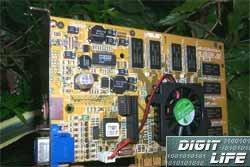 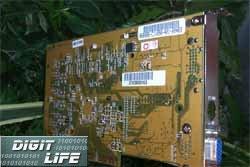 The card has AGP2x/4x interface, 64 MBytes 6 ns DDR SDRAM memory located in 8 chips on the right side of PCB: 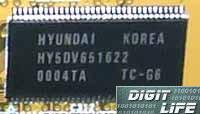 The memory chips are made by Hyundai and should work at 166 MHz. And they do work at this frequency. Note that sometimes the resulting clock frequency of DDR memory given is twice as high as it actually is, because these numbers look more impressive. However, it hardly matters for reality. In other words, if you see that DDR memory working frequency is written equal to 333 MHz, then you should read it as 166 MHz. Let's turn again to the speed of memory. As shows the example of ATI RADEON 64 MBytes there is quicker memory than 166 MHz ( f.e. 183 MHz or 200 MHz). It is unclear, why NVIDIA still provide the manufacturers of GPU GeForce2 GTS videocards with less-speed memory chips. Probably, in the past they purchased quite a lot of 166 MHz memory. This card has a usual active cooler which ASUS set on many cards. The cooler has no a tachometer. The card hasn't got SmartDoctor system either, and it's vague why the designers hasn't put special hardware monitoring microchip on the quite expensive videocard. It looks like that ASUS hurried producing this card and decided just to use a reference design from NVIDIA. The further examination of PCB has proved it. The card is of vivid yellow color. The PCB is already equipped with a connector for a daughter card with a TV-Out (the card itself is absent). Besides, the graphics card has a special empty slot for digital monitors connector. The graphics card is supplied in typical box with some abstract picture, which sense is too hidden for us to perceive it. 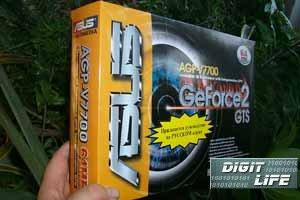 The package includes a user's manual and 4 CD disks with the software:
We can't help reproaching the company for supplying such outdated games with a brand new graphics card. They should have been ashamed to do so. OverclockingThe practice shows that using the memory by Hyundai usually provides perfect overclockability. And all our expectations came true. We managed to make the graphics processor work stable at 230 MHz, while the memory showed stable functioning at the end frequencies of up to 400 MHz. We would like to stress that this frequency is the today's nearly record: only ASUS AGP-V7700 (32 MBytes) managed to show the better overclocking results. That is why when the memory works at the higher frequency the performance gain is expected to grow. The memory overclocking effects the performance best of all. Now let's pass over to the practical part of our study. At first take a look at the configuration of our test systems: Platform based on Pentium III:
The test system used ViewSonic P810 (21") monitor. Since the drivers set for the given card doesn't differ from those described in the previous cards reviews of the company ASUSTeK, we won't talk about it any more. If you want a detailed installation description, please, refer to the ASUS AGP-V7700 reviews. (Notice that for our tests we installed ASUS drivers version 5.32 beta). Test resultsWe will start with 2D graphics. In the previous review we mentioned very good quality and excellent performance in 2D shown by the reference card on GeForce2 GTS from NVIDIA. We are happy to state that in 2D ASUS AGP-V7700/64 card proved not in the least worse than the previously tested pieces (it seems to be the similarity to NVIDIA reference design that tells). The image quality provided by the graphics cards of this type meets all the requirements of the absolute majority of users. And now that the 2D graphics quality of NVIDIA GeForce2 GTS based cards has been significantly improved compared to GeForce256 based cards, even the owners of good 21" monitors should be pleased. Note that we said "good" monitors! The same thing refers to smaller monitors as well. We will use the following two games to consider the performance of ASUS AGP-V7700/64 in 3D-graphics:
These tools should be quite enough to give you a full idea of the graphics card performance when working via two main API. For a more illustrative comparison we also added the speed results shown by two more graphics cards to our diagrams: ATI RADEON 64 MBytes VIVO and ASUS AGP-V7700 based on GeForce2 GTS. We will also show the performance of the overclocked ASUS AGP-V7700/64. 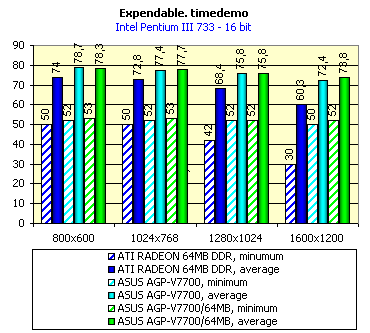 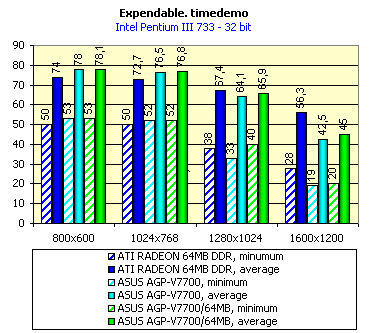 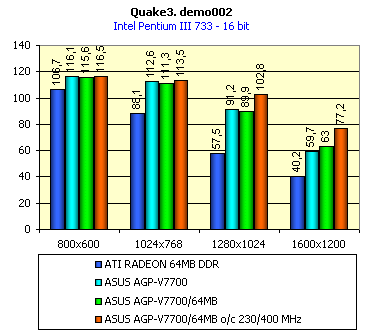 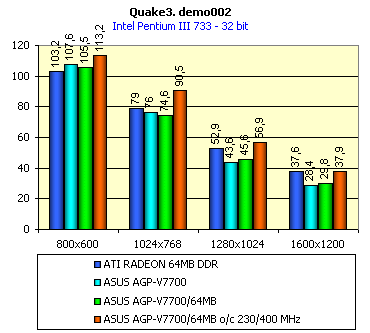 You can easily notice that ASUS AGP-V7700/64 performs very close to the previous modification ASUS AGP-V7700 excelling the latter only in the highest resolutions, though just a little. ATI RADEON 64 MBytes VIVO is the best in 32bit color mode. It proves again that a faster memory is much better rather than a size extend. ATI RADEON memory works at 183 (366) MHz unlike ASUS AGP-V7700/64 memory frequency of which is166 (333) MHz. And only the overclocking of the test sample showed what the chip GeForce2 GTS is capable of at a faster memory. The overclocking of a graphics core meant a little. The performance gain was mainly provided by the memory being stable at 200 (400) MHz. We should notice that the ASUSTeK card worked at the minimum extra cooling (the system unit has just one extra fan to keep up air circulation). Of course, we can't generalize the results shown by this graphics card and refer them to all cards based on GeForce2 GTS, however, we have every reason to hope that overclocking lovers will easily find a nice piece among them for their extreme needs. As you can see, the studying of the games where 32 MBytes card size is quite enough and AGP-texturing is involved, the installation of 64 MBytes card gives a little, nearly zero. However, let's look at the game Quake3 ( level q3dm9) with this card used, where there are many large textures, and you'll see a different picture (while testing, the options were at maximum: both the geometry level and textures detailization level): 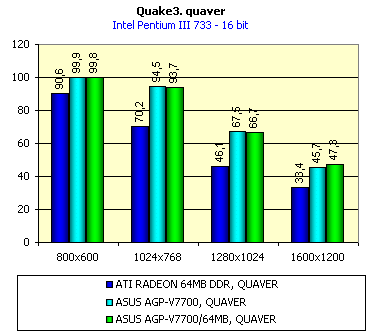 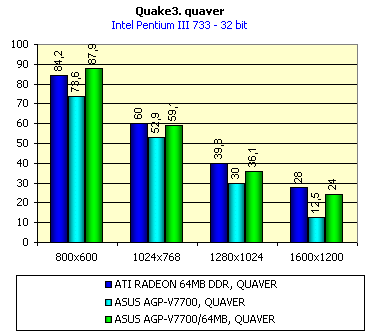 If in 16-bit color mode nothing has changed, then, when 32-bit color mode used and the sizes of the textures when driven through the memory are more than free local memory size (32 MBytes), using of 64 MBytes cards becomes significant. We should notice that ASUS AGP-V7700/64 got right up to ATI RADEON 64 MBytes VIVO, though it hasn't overspeeded yet. These results are especially of interest when similar videocards are used for programs which operate with large textures or complex multipolygon objects. Games of that class have not yet appeared but for several scenes in Quake3 and alike games, or demo-programs. DVD-Video did not cause any remarks. ASUS DVD 2000 player supplied with the graphics card (based on PowerDVD engine version 2.5) installed without any problems and the image quality proved just perfect. The CPU utilization during the DVD Video playback didn't exceed 32%. ConclusionsSo, ASUS AGP-V7700/64 is a development of AGP-V7700 series (in terms of local memory increase and increase in price) and it doesn't yield to the latter at all. We have to stress here that the performance of ASUS AGP-V7700/64 is as high as 32 MBytes performance although they differ in price. Nowadays we have quite a few applications where a graphics accelerator needs 64 MBytes local memory. And we'll remind you that ASUS AGP-V7700/64 doesn't have a card condition monitoring. So, the difference in price between ASUS AGP-V7700 and ASUS AGP-V7700/64 makes no sense. Nevertheless, we are not strict judges because we have a lot of other applications left where this card can prove to have a performance gain in comparison with more expensive applications. We must stress that ASUS AGP-V7700/64 is much more overclockable. But the card's overclockability is unique for each particular piece. However, we won't hesitate a second and recommend ASUS AGP-V7700/64 card for those of you who always buy the newest fastest gaming products. Highs
Lows
Write a comment below. No registration needed!
|
Platform · Video · Multimedia · Mobile · Other || About us & Privacy policy · Twitter · Facebook Copyright © Byrds Research & Publishing, Ltd., 1997–2011. All rights reserved. |